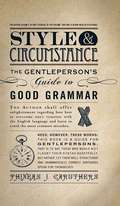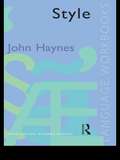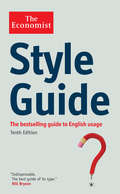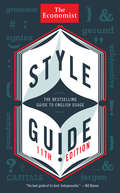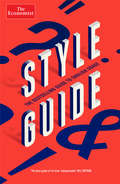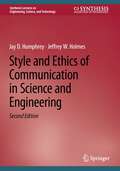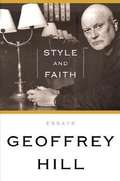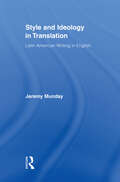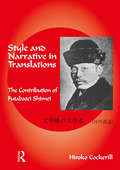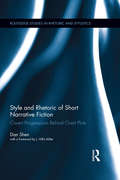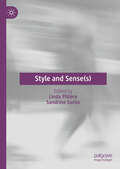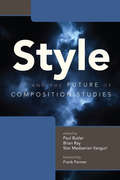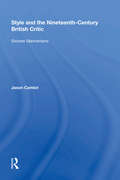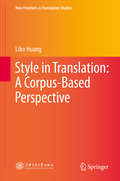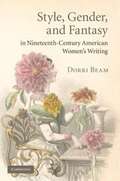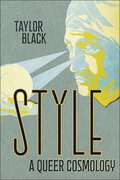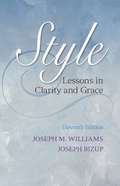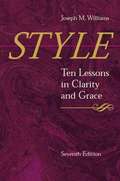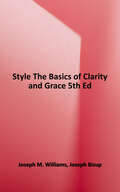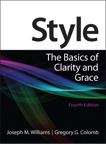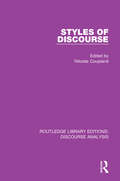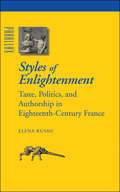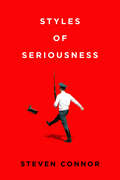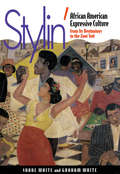- Table View
- List View
Style & Circumstance: The Gentleperson's Guide to Good Grammar
by Phineas J CaruthersStressed over syntax? Unsure about noun/verb agreement? Afraid to commit a grammatical faux pas? Fear not, dear reader. You have found yourself the perfect guide to proper grammar and style. This refresher on the modern rules of writing will help you regain your masterful grip of the English language.With plenty of instruction as well as a little pomp, this book entertains as it enlightens, making your reading experience enjoyable and your knowledge sound.
Style (Language Workbooks)
by John HaynesIn Style, John Haynes provides a lively introduction to the study of expression in relation to meaning. Style: * introduces readers to the key areas in the study of style through practical exercises* encourages an interest in and sensitivity to words and structures* enables students to recognize contrasts within and between texts* heightens awareness with regards to word choice, meaning, communicative purpose and stylistic convention* examines an enormous variety of text-types; both literary and non-literary, spoken and written* in addition to numerous exercises, contains suggestions for project work.
Style Guide
by Bill BrysonThis expanded tenth edition of the bestselling guide to style is based on the Economist's own updated house style manual, and is an invaluable companion for everyone who wants to communicate with the clarity, style and precision for which the Economist is renowned. As the introduction says, 'clarity of writing usually follows clarity of thought. ' The Economist Style Guide gives general advice on writing, points out common errors and clichés, offers guidance on consistent use of punctuation, abbreviations and capital letters, and contains an exhaustive range of reference material - covering everything from accountancy ratios and stock market indices to laws of nature and science. Some of the numerous useful rules and common mistakes pointed out in the guide include: *Which informs, that defines. This is the house that Jack built. But: This house, which Jack built, is now falling down. *Discreet means circumspect or prudent; discrete means separate or distinct. Remember that "Questions are never indiscreet. Answers sometimes are" (Oscar Wilde). *Flaunt means display, flout means disdain. If you flout this distinction you will flaunt your ignorance *Forgo means do without; forego means go before. *Fortuitous means accidental, not fortunate or well-timed. *Times: Take care. Three times more than X is four times as much as X. *Full stops: Use plenty. They keep sentences short. This helps the reader.
Style Guide
by The Economist Newspaper Ltd.This expanded eleventh edition of the bestselling guide to style is based on the Economist's own updated house style manual, and is an invaluable companion for everyone who wants to communicate with the clarity, style and precision for which the Economist is renowned. As the introduction says, 'clarity of writing usually follows clarity of thought. ' The Economist Style Guide gives general advice on writing, points out common errors and clichés, offers guidance on consistent use of punctuation, abbreviations and capital letters, and contains an exhaustive range of reference material - covering everything from accountancy ratios and stock market indices to laws of nature and science. Some of the numerous useful rules and common mistakes pointed out in the guide include: *Which informs, that defines. This is the house that Jack built. But: This house, which Jack built, is now falling down. *Discreet means circumspect or prudent; discrete means separate or distinct. Remember that "Questions are never indiscreet. Answers sometimes are" (Oscar Wilde). *Flaunt means display, flout means disdain. If you flout this distinction you will flaunt your ignorance *Forgo means do without; forego means go before. *Fortuitous means accidental, not fortunate or well-timed. *Times: Take care. Three times more than X is four times as much as X. *Full stops: Use plenty. They keep sentences short. This helps the reader.
Style Guide (Economist Books)
by The EconomistThis expanded twelfth edition of the bestselling guide to style is based on The Economist's own updated house style manual, and is an invaluable companion for everyone who wants to communicate with the clarity, style and precision for which The Economist is renowned.As the introduction says, 'clarity of writing usually follows clarity of thought.'The Economist Style Guide gives general advice on writing, points out common errors and clichés, offers guidance on consistent use of punctuation, abbreviations and capital letters and contains an exhaustive range of reference material--covering everything from accountancy ratios and stock market indices to laws of nature and science.Some of the numerous useful rules and common mistakes pointed out in the guide include:Which informs, that defines. This is the house that Jack built. But: This house, which Jack built, is now falling down.Discreet means circumspect or prudent; discrete means separate or distinct. Remember that "Questions are never indiscreet. Answers sometimes are" (Oscar Wilde).Flaunt means display, flout means disdain. If you flout this distinction you will flaunt your ignorance.Forgo means do without; forego means go before.Fortuitous means accidental, not fortunate or well-timed.Times: Take care. Three times more than X is four times as much as X.Full stops: Use plenty. They keep sentences short. This helps the reader.
Style and Ethics of Communication in Science and Engineering (Synthesis Lectures on Engineering, Science, and Technology)
by Jay D. Humphrey Jeffrey W. HolmesThis book serves as a valuable aid for scientists and engineers who seek to discover and disseminate knowledge so that it can be used to improve the human condition. This book can be used as a textbook for undergraduate or graduate courses on technical communication and ethics, a reference book for senior design courses, or a handbook for young investigators and beginning faculty members.In addition to presenting methods for writing clearly and concisely and improving oral or poster presentations, this compact book provides practical guidelines for preparing theses, dissertations, journal papers for publication, and proposals for research funding. Issues of authorship, peer review, plagiarism, recordkeeping, transparency, and copyright are addressed in detail, and case studies of research misconduct highlight the need for proactive attention to scientific integrity. Ample exercises cause the reader to stop and think. The authors motivate the reader to develop an effective, individual style of communication and a personal commitment to integrity, each of which are essential to success in the workplace.
Style and Faith
by Geoffrey HillSeven essays on the moral life of literature and the moral burden of the poet seek to rescue key literary works from misinterpretation, in a collection that covers such texts as the Oxford English Dictionary, Tyndale's Bible, and poems by Henry Vaughan and T.S. Eliot.
Style and Ideology in Translation: Latin American Writing in English (Routledge Studies in Linguistics #Vol. 8)
by Jeremy MundayAdopting an interdisciplinary approach, this book investigates the style, or ‘voice,’ of English language translations of twentieth-century Latin American writing, including fiction, political speeches, and film. Existing models of stylistic analysis, supported at times by computer-assisted analysis, are developed to examine a range of works and writers, selected for their literary, cultural, and ideological importance. The style of the different translators is subjected to a close linguistic investigation within their cultural and ideological framework.
Style and Narrative in Translations: The Contribution of Futabatei Shimei
by Hiroko CockerillFutabatei Shimei (1864-1909) is widely regarded as the founder of the modern Japanese novel. His novel Floating Clouds (1887-1889) was written in a colloquial narrative style that was unprecedented in Japanese literature, as was its negative hero. Futabatei was also a pioneer translator of Russian literature, translating works by Turgenev, Gogol, Tolstoy, Gorky and others - his translations had an enormous impact (perhaps even greater than his novels) on the development of Japanese literature. In this groundbreaking work, Hiroko Cockerill analyses the development of Futabatei's translation style and the influence of his work as a translator on his own writing. She takes us on a journey through Russian and Japanese literature, throwing light on the development of Japanese literary language, particularly in its use of verb forms to convey notions of tense and aspect that were embedded in European languages. Cockerill finds that Futabatei developed not one, but two distinctive styles, based on the influences of Turgenev and Gogol. While the influence of his translations from Turgenev was immediate and far-reaching, his more Gogolian translations are fascinating in their own right, and contemporary translators would do well to revisit them.
Style and Rhetoric of Short Narrative Fiction: Covert Progressions Behind Overt Plots (Routledge Studies in Rhetoric and Stylistics #7)
by Dan ShenIn many fictional narratives, the progression of the plot exists in tension with a very different and powerful dynamic that runs, at a hidden and deeper level, throughout the text. In this volume, Dan Shen systematically investigates how stylistic analysis is indispensable for uncovering this covert progression through rhetorical narrative criticism. The book brings to light the covert progressions in works by the American writers Edgar Allan Poe, Stephan Crane and Kate Chopin and British writer Katherine Mansfield.
Style and Sense(s)
by Sandrine Sorlin Linda PillièreThis edited volume celebrates cutting-edge research in stylistics and, more specifically, recent work on sense and the senses. The title originated in the Poetics and Linguistics Association (PALA) 2022 conference and marks the 40th onsite event by showcasing some of the excellent papers delivered on that occasion. The selected chapters fall into 4 parts each of which gives pride of place to how style makes sense and how senses make style. The chapters follow research in neuroscience and sociocognition, investigate how body and mind are inextricably linked through embodied meaning; how emotions are both conveyed and perceived; and how impressions, thoughts and worldviews can be induced by a certain style. The apprehension of the senses is carried through a variety of theories (cognitive linguistics and stylistics, ecostylistics, phenomenology, simulation theory, enactivism, metaphor theory, Text World Theory) and is applied to various genres (poetry, novels, short stories, detectivefiction, restaurant reviews) and media (the oral vs written tradition, ekphrasis, and semiotic transfers). This book will be of interest to students and academics in stylistics, cognitive linguistics, discourse analysis, ecostylistics, and multimodality.
Style and the Future of Composition Studies
by Paul Butler Brian Ray Star VanguriStyle and the Future of CompositionStudies explores style’s potential for informing how students are taught to write well and its power as a tool for analyzing the language and discourse practices of writers and speakers in a range of contexts. Many college writing teachers operate under the belief that style still refers primarily to the kinds of issues discussed in Strunk and White’s popular but outdated book The Elements of Style. This work not only challenges this view but also offers theories and pedagogies from diverse perspectives that help teachers and students develop strategic habits and mindsets to negotiate languages, genres, and discourse conventions. The chapters explore the ways in which style directly affects—and is affected by—multiple sources of shifting disciplinary inquiry, contributing new insights by drawing on research in cultural studies, sociolinguistics, discourse studies, translingualism, and writing across the curriculum, as well as new approaches to classical rhetorical theory. The reemergence of stylistic inquiry can be used dynamically to produce new insights not only about emerging disciplinary interests but also about the study of style as a kind of language in and of itself. Style and the Future of Composition Studies demonstrates that style deserves to be a central focus of writing teaching. More than just the next style collection, the book advocates for style’s larger prominence in composition discussions generally. It will be of interest to a broad range of students and scholars of writing studies, as well as a wider set of readers in academe. Contributors: Cydney Alexis, Laura Aull, Anthony Box, Jimmy Butts, Mike Duncan, William FitzGerald, Melissa Goldthwaite, Eric House, TR Johnson, Almas Khan, Zak Lancaster, Eric Leake, Andrea Olinger, Thomas Pace, Jarron Slater, Jonathan Udelson
Style and the Nineteenth-Century British Critic: Sincere Mannerisms
by Jason CamlotIn analyzing the nonfiction works of writers such as John Wilson, J. S. Mill, De Quincy, Ruskin, Arnold, Pater, and Wilde, Jason Camlot provides an important context for the nineteenth-century critic's changing ideas about style, rhetoric, and technologies of communication. In particular, Camlot contributes to our understanding of how new print media affected the Romantic and Victorian critic's sense of self, as he elaborates the ways nineteenth-century critics used their own essays on rhetoric and stylistics to speculate about the changing conditions for the production and reception of ideas and the formulation of authorial character. Camlot argues that the early 1830s mark the moment when a previously coherent tradition of pragmatic rhetoric was fragmented and redistributed into the diverse, localized sites of an emerging periodicals market. Publishing venues for writers multiplied at midcentury, establishing a new stylistic norm for criticism-one that affirmed style as the manifestation of English discipline and objectivity. The figure of the professional critic soon subsumed the authority of the polyglot intellectual, and the later decades of the nineteenth century brought about a debate on aesthetics and criticism that set ideals of Saxon-rooted 'virile' style against more culturally inclusive theories of expression.
Style in Translation: A Corpus-Based Perspective
by Libo HuangThis book attempts to explore style--a traditional topic--in literary translation with a corpus-based approach. A parallel corpus consisting of the English translations of modern and contemporary Chinese novels is introduced and used as the major context for the research. The style in translation is approached from perspectives of the author/the source text, the translated texts and the translator. Both the parallel model and the comparable model are employed and a multiple-complex model of comparison is proposed. The research model, both quantitative and qualitative, is duplicable within other language pairs. Apart from the basics of corpus building, readers may notice that literary texts offer an ideal context for stylistic research and a parallel corpus of literary texts may provide various observations to the style in translation. In this book, readers may find a close interaction between translation theory and practice. Tables and figures are used to help the argumentation. The book will be of interest to postgraduate students, teachers and professionals who are interested in corpus-based translation studies and stylistics.
Style, Gender, and Fantasy in Nineteenth-Century American Women's Writing
by Dorri BeamDorri Beam presents an important contribution to nineteenth-century fiction by examining how and why a florid and sensuous style came to be adopted by so many authors. Discussing a diverse range of authors, including Margaret Fuller and Pauline Hopkins, Beam traces this style through a variety of literary endeavors and reconstructs the political rationale behind the writers' commitments to this form of prose. Beam provides both close readings of a number of familiar and unfamiliar works and an overarching account of the importance of this form of writing, suggesting new ways of looking at how gender determines literary style. Style, Gender, and Fantasy in Nineteenth Century American Women's Writing redefines our understanding of women's relation to aesthetics and their contribution to both American literary romanticism and feminist reform. This illuminating account provides valuable new insights for scholars of American literature and women's writing.
Style: A Queer Cosmology (Postmillennial Pop #37)
by Taylor BlackAssembles texts, performances, and personae from American culture to assert the elemental natureof styleWhile “style” is equated with fashion or convention in common parlance, Style: A Queer Cosmology defines the term as a mode of expression that makes us more like ourselves and less like everyone else. Taylor Black’s interdisciplinary conceptual analysis assembles texts, performances, and personae from American culture that engage in ethical, creative, and performative modes of what he terms “abundant revelation.” Moving back and forth through time, this book sketches American cosmologies cultivated by iconic and subterranean American artists like Edgar Allan Poe, Flannery O’Connor, Nikki Giovanni, and Bob Dylan. Presiding throughout is the book’s conceptual guide: latter-day American and notorious homosexual Quentin Crisp, resurrected here as a philosopher of style.As a scholarly intervention, Style participates in the critical work of revival and attunement—revitalizing figures, terms, and ideas that have become too familiar. Returning to viewing the critic as a stylist, Style: A Queer Cosmology leans into the study of things and qualities that are immanent and elude paraphrase or social scientific categorization. Style is about the possible rather than the probable, singularity over universals, personality instead of identity, the emergent and not the new—the mystery of becoming.
Style: Lessons in Clarity and Grace Eleventh Edition
by Joseph M. Williams Joseph BizupWilliams' own clear, accessible style models the kind of writing that audiences-both in college and after-will admire. The principles offered here help writers understand what readers expect and encourage writers to revise to meet those expectations more effectively. This book is all you need to understand the principles of effective writing.
Style: The Basics of Clarity and Grace
by Joseph Bizup Joseph WilliamsStyle: The Basics of Clarity and Grace reflects the wisdom and clear authorial voice of Williams' best-selling book, Style: Lessons in Clarity and Grace, while streamlining every chapter to create a very brief, yet powerfully direct guide to writing with style. The concise clarity of this book makes it a handy reference for anyone interested in good writing--as well as a quick and ideal guide for freshman composition courses, writing courses across the disciplines, and as a supporting text in courses that require clear and direct writing. Style: The Basics covers the elemental principles of writing that will help students diagnose the strengths and weaknesses of their prose quickly and revise effectively. The text features principles of effective prose written in Williams' hallmark conversational style, offering reason-based principles, rather than hard and fast rules, for successful, effective writing.
Style: The Basics of Clarity and Grace (4th Edition)
by Joseph M. Williams Gregory G. ColombStyle: The Basics of Clarity and Grace reflects the wisdom and clear authorial voice of Williams' best-selling book, Style: Lessons in Clarity and Grace, while streamlining every chapter to create a very brief, yet powerfully direct guide to writing with style. The concise clarity of this book makes it a handy reference for anyone interested in good writing.
Styles of Discourse (RLE: Discourse Analysis)
by Nikolas CouplandFirst published in 1988, this book focuses on diversity and discourse, and collects contemporaneous research across a wide range of topics including: description, polemic, narrative analysis, DJ talk, philosophical history, conversation, children’s books and nuclear deterrence. The essays demonstrate analyses of discourse in the service of stylistic inquiry, exploring relationships of text and context. This reflects the overall argument that discourse analyses aiming to represent diversity of social context will necessarily approach the task selectively, since all dimensions are of potential relevance to any and every communicative manifestation. Some of contextual dimensions that are addressed include: interpersonal, socio-structural, modal, ideological, and pragmatic.
Styles of Enlightenment: Taste, Politics, and Authorship in Eighteenth-Century France (Parallax: Re-visions of Culture and Society)
by Elena RussoStyles of Enlightenment argues that alongside its democratic ideals and its efforts to create a unified public sphere, the Enlightenment also displayed a tendency to erect rigid barriers when it came to matters of style and artistic expression. The French philosophes tackled the issue of the hierarchy of genres with surprising inflexibility, and they looked down on those forms of art that they saw as commercial, popular, and merely entertaining. They were convinced that the standard of taste was too important a matter to be left to the whims of the public and the vagaries of the marketplace: aesthetic judgment ought to belong to a few, enlightened minds who would then pass it on to the masses.Through readings of fictions, essays, memoirs, eulogies, and theatrical works by Fénelon, Bouhours, Marivaux, Montesquieu, Voltaire, Diderot, Rousseau, Mercier, Thomas, and others, Styles of Enlightenment traces the stages of a confrontation between the virile philosophe and the effeminate worldly writer, "good" and "bad" taste, high art and frivolous entertainment, state patronage and the privately sponsored marketplace, the academic eulogy and worldly conversation. It teases out the finer points of division on the public battlefields of literature and politics and the new world of contesting sexual economies.
Styles of Seriousness
by Steven ConnorBeing serious demands serious kinds of work. In Styles of Seriousness, Steven Connor reflects on the surprisingly various ways in which a sense of the serious is made and maintained, revealing that while seriousness is the most powerful feeling, it is also the most poignantly indeterminate, perhaps because of the impossibility of being completely serious. In colloquy with philosophers such as Aristotle, Nietzsche, James, Sartre, Austin, Agamben and Sloterdijk, and writers like Shakespeare, Byron, Auden and Orwell, Connor considers the linguistic and ritual behaviors associated with different modes of seriousness: importance; intention, or ways of really "meaning things;" sincerity; solemnity; urgency; regret; warning; and ordeal. The central claim of the book is human beings are capable of taking things seriously in a way that nonhuman animals are not, for the unexpected reason that human beings are so much more versatile than most animals at not being completely serious. One always, in fact, has a choice about whether or not to take seriously something that is supposed to be so. As a consequence, seriousness depends on different kinds of formalization or stylized practice. Styles of seriousness matter, Connor shows, because human beings are incapable of simply and spontaneously existing. Being a human means having to take seriously one's style of being.
Stylin': African-American Expressive Culture, from Its Beginnings to the Zoot Suit
by Shane White Graham WhiteFor over two centuries, in the North as well as the South, both within their own community and in the public arena, African Americans have presented their bodies in culturally distinctive ways. Shane White and Graham White consider the deeper significance of the ways in which African Americans have dressed, walked, danced, arranged their hair, and communicated in silent gestures. They ask what elaborate hair styles, bright colors, bandanas, long watch chains, and zoot suits, for example, have really meant, and discuss style itself as an expression of deep-seated cultural imperatives. Their wide-ranging exploration of black style from its African origins to the 1940s reveals a culture that differed from that of the dominant racial group in ways that were often subtle and elusive. A wealth of black-and-white illustrations show the range of African American experience in America, emanating from all parts of the country, from cities and farms, from slave plantations, and Chicago beauty contests. White and White argue that the politics of black style is, in fact, the politics of metaphor, always ambiguous because it is always indirect. To tease out these ambiguities, they examine extensive sources, including advertisements for runaway slaves, interviews recorded with surviving ex-slaves in the 1930s, autobiographies, travelers' accounts, photographs, paintings, prints, newspapers, and images drawn from popular culture, such as the stereotypes of Jim Crow and Zip Coon.
